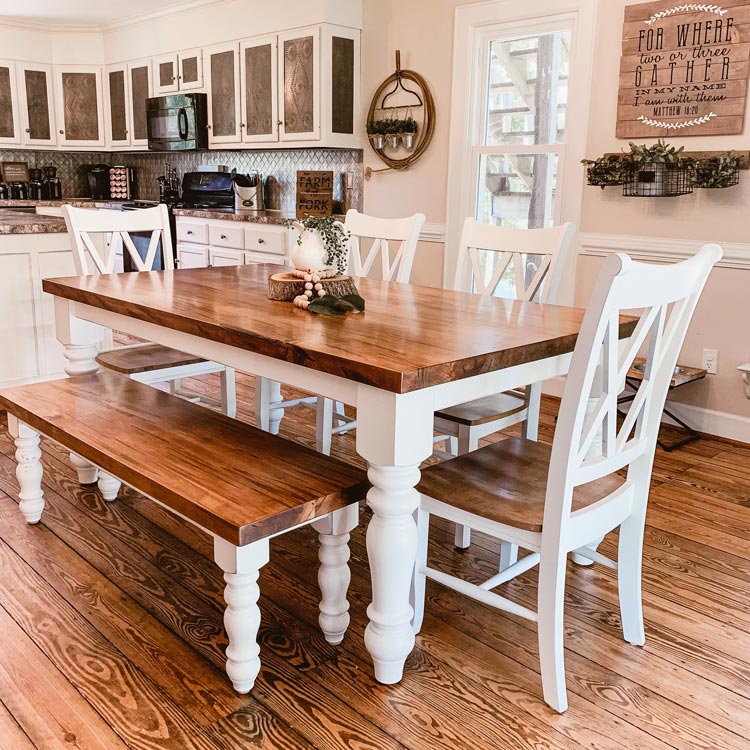Simple Steps to Replacing Old Dining Room Table Legs with New Ones
Simple Steps to Replacing Old Dining Room Table Legs with New Ones
Blog Article
From Typical to Modern: Find the Ideal Dining-room Table Legs for Your Design
While timeless layouts such as cabriole and turned legs stimulate a feeling of timeless class, modern styles like hairpin and geometric choices offer an opportunity for striking aesthetic rate of interest. As you take into consideration these elements, the question stays: how can you seamlessly integrate these diverse leg designs to develop a harmonious eating experience?
Comprehending Table Leg Styles
The selection of eating area table leg designs can dramatically affect both the aesthetics and capability of the space. Each leg design adds one-of-a-kind sensible features and aesthetic elements, accommodating varied style preferences and usage requirements. Understanding these designs is crucial for selecting the right table that straightens with your total interior decoration vision.
For example, tapered legs offer a tidy, timeless look that can enhance a space's elegance, while stand bases give security and make the most of legroom, making them suitable for smaller spaces. Barrette legs, a trademark of mid-century contemporary style, introduce a commercial flair, allowing for a ventilated, open feeling. Trestle legs evoke rustic beauty, supplying robust assistance and a sense of eternity.
Wood legs can bring warmth and texture, whereas steel alternatives commonly share a streamlined, modern vibe. Eventually, understanding table leg styles is necessary for creating a cohesive eating area that reflects individual design while ensuring functionality and convenience.
Traditional Table Leg Options
When selecting dining-room table legs, traditional choices commonly personify timeless beauty and workmanship. These styles mirror a rich heritage and a dedication to quality, making them perfect for those who value traditional visual appeals.
One of the most famous standard leg styles is the cabriole leg, identified by its elegant bent form. This layout often includes attractive makings and is most commonly found in Queen Anne and Chippendale furniture. An additional preferred alternative is the transformed leg, which flaunts a collection of smooth, rounded shapes that supply a timeless appearance while preserving stability.
Furthermore, the straight leg, while easy, provides a durable and unadorned framework that can mix flawlessly with a selection of tabletop designs. For those drawn to ornate outlining, claw-and-ball feet legs evoke a sense of majesty and can act as a sensational focal factor in any type of dining space.
Last but not least, pedestal bases, although not strictly legs, provide an alternative typical choice that enables adequate legroom and can be magnificently carved. Each of these typical leg designs adds to the general ambiance of an eating space, marrying function with aesthetic allure.

Modern Table Leg Designs
Modern table leg designs supply a diverse variety of styles that stress ingenious products and clean lines. These styles frequently prioritize capability while serving as striking centerpieces within a dining space. Minimal aesthetic appeals prevail, with Visit Website legs crafted from products such as steel, glass, and engineered timber, which add to a ventilated and contemporary feel.
One prominent style is the barrette leg, defined by its slim, conical structure that gives stability without overwhelming the table top (dining room table legs). This style is often discovered in mid-century modern-day furniture and can effortlessly match different dining table shapes. Another pattern is using geometric forms, where legs may handle unbalanced or angular forms, adding aesthetic interest and a touch of creativity

Mixing Designs for Distinct Spaces
Typically, house owners seek to create unique eating areas that reflect their individual design by blending various design components. This method allows for the incorporation of varied appearances, causing a harmonious yet distinctive environment. Combining a rustic wooden table with streamlined, contemporary steel legs can produce an appealing comparison that raises the area's general appeal.
In addition, integrating vintage table legs with contemporary tabletops can stimulate a sense of background while preserving a modern perceptiveness. Such combinations not just showcase private taste but additionally motivate creativity, allowing property owners to curate an area that feels both individual and welcoming.
Shade plays an essential role in this blending procedure; choosing table legs that enhance or contrast with the existing color pattern can improve aesthetic rate of interest. Whitewashed legs can soften the boldness of a dark table surface, developing a well balanced aesthetic.
Tips for Selecting the Right Legs
Picking the right table legs is vital for attaining both performance and visual allure in your eating space. Begin by taking into consideration the overall style of your space. Typical setups take advantage of legs that feature complex makings or transformed designs, while modern areas may ask for streamlined, minimalist styles.
Next, evaluate the height and security of the legs. dining room table legs. Standard dining tables range between 28 to 30 inches in elevation, so make certain the legs complement this measurement for comfort. In addition, robust materials, such as hardwood or metal, can improve security and durability
Evaluate the leg form too-- options include straight, tapered, or pedestal layouts. Straight legs supply a classic look, while conical legs can include a touch of elegance. Pedestal bases supply ample legroom and are perfect for smaller spaces.
Conclusion
In summary, choosing the suitable dining area table legs needs careful factor to consider of both modern and typical styles. By integrating leg design, elevation, and material with the general decoration, a natural and inviting ambience can be accomplished.
The variety of eating space table leg styles can substantially affect both the visual appeals and performance of the room. Inevitably, recognizing table leg designs is crucial for developing a natural dining location that mirrors personal design while ensuring practicality and comfort.One of the most iconic standard leg designs is the cabriole leg, identified by its graceful check this rounded form. Straight legs offer a traditional appearance, while tapered legs can include a touch of sophistication.In recap, choosing the excellent dining space table legs calls for careful factor to consider of both modern and conventional designs.
Report this page